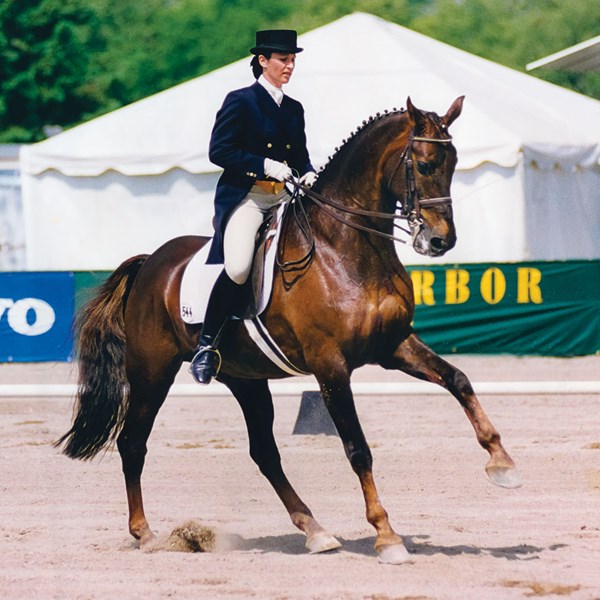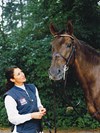
In this series, top trainers tell how they were temporarily stumped at some point in their careers. These tales are fascinating because most of us see only the finished product at a show or on a video and assume the training must have gone smoothly. Certainly, the best riders make it look that way. The manner in which the toughest training challenge is resolved is a lesson in persistence, patience and good horsemanship.
Dressage Today asked me to write about my most difficult training problem and how I solved it. When I mulled over the many correction cases that have passed through my stable, the clear, logical solutions to typical training problems did not make the biggest impressions. My most difficult case could not be solved with good basics like the others, and I hope that my readers will not be disappointed when this story ends without a technical solution. Sometimes all of our analytical and technical skills are humbled by the mystic power of the horse.
My first successful Fédération Equestre Internationale (FEI) horse was named Izotops. This is his story: Izotops was a Russian Warmblood of mysterious origins who came to me in Germany shortly after I set up my first training stable in Vechta. He was a chestnut with an unfortunate neck and eagle eyes that stared past me if I happened to get in his line of sight. I was told that he had competed at Grand Prix and he even had a CDI participation stamp in his passport. But I could find no other confirmation that he was even remotely trained.
In the first weeks that Izotops was in my stable, he would not acknowledge my presence, even if I arrived with apples and carrots. He would not take sugar from me. He did not toss his head, nicker or even look toward his feed tub while the rest of the horses created the usual din during feeding time. He ate his meals after the aisle went quiet during the lunch break and after the lights went out at night.
He was not aggressive. Quite the contrary: Izotops did not overtly react to any kind of stimulus. I could enter his box, put the halter on, pick his feet out, groom him, tack him up and take him to the arena for his daily training without him actually interacting with me in any way. He was glassy-eyed and expressionless. He just did what he was told. The pinnacle of this remarkable state of trance occurred if something disturbed him when he was cross-tied. He would piaffe in place with perfect robotic rhythm, no tension and no expression. I could make him stop only by freeing and walking him forward.
In the arena—indoor and outdoor—he was much the same. He would trot when told. But he would not change his trot, slower or faster. He would canter when told, but he would not change his canter. He would do a perfect flying change several strides after he was asked. He was, simply put, dead to the aids.
Izotops performed this limited repertoire every day for three weeks. However, he refused to bow his head while doing it. I, Catherine Haddad, educated by two of the finest masters of dressage—Bodo Hangen and his legendary teacher, Willi Schultheis—could not get Izotops on the bit.
Fortunately, I knew before I even made an attempt to ride Izotops that he was inexplicably difficult. When he had first arrived, I had watched my then-partner try every gadget and every method of persuasion (including frustrated tears) to get through to this horse. He had turned Izotops over to me after only a few days, nearly begging me to “do something to make him go.”
I took a deep breath and called on all the knowledge I had at that time to help me. I never used anything but a simple double bridle, normal spurs, a light tap of the whip and my seat. I was patient. If I sat the trot and touched my hands together in front of me and just waited for three to four revolutions of the arena, he would drop his head into my contact for two or three strides before inverting himself again.
So I took my time. I rode diligently and correctly every day. But I could not create enough impulsion to make Izotops connect to my hand for more than a fleeting moment even though I stuck by my principles. I refused to pull back against his mouth and his inverted neck. I had set the rules—he would go to my hand because I drove him there. I would not use draw reins, I would not pull on him. I would not beat him. I would simply push him forward into a light contact until he submitted. The choice would be his. Or I would give up.
Eventually, I gave up. Izotops was clearly somewhere else in his head, speaking a completely different language (if he were communicating at all). I did not understand him. I could not ride him. And because I had failed, I would have to send him back to where he came from.
With a heavy heart, I chose in that moment to canter straight out of the dressage arena and onto the path that led into the forest. His head was up, his lower neck was stuck out and he loped along as disinterested in the change of venue as he was in all other things.
Eventually we slowed to a lazy walk and I talked to Izotops in English—my language. I told him that I was sorry. I told him that I was just starting in my career and that I could not afford to keep a horse just because I wanted to save him. I told Izotops that I needed room in my stable for the horses that could help me become a better rider. I remember pleading with him in one final attempt at interaction, “C’mon dude, show me a sign!”
In the next moment he arched his neck, picked up his withers and caused me to frantically gather up my reins as he stepped off into elevated, powerful, forward-thrusting passage. A few breathless strides later, I asked for a canter depart that resulted in a string of one tempis down the forest path. I laughed. I opened my heart and I let this horse delight me. I tried not to think and not to analyze. And I stayed on as Izotops turned the one tempis into a series of crow hops, which was probably a deciding factor in the formation of our future partnership.Elated, we returned to the stable that day in a state of true submission—we had an agreement to work together.
The next day, having come to the logical conclusion that Izotops was horribly ring sour, I started his warm up in the forest. He was forward and light. So I cantered him from the path straight back into the arena, a reverse route from the day before.
If he had truly been ring sour, he let it go on that day and never looked back. I touched my hands together and I agreed to be soft; he dropped his neck into my contact and agreed to be forward. As long as we respected those rules, our work was always play. I won my first three FEI-level tests with Izotops in Germany later that year. He was the first horse to help me start a successful career.
To this day I cannot explain what happened in technical terms. I didn’t train Izotops or solve his problems. We began to dance together because of a decision that he made, not something that I did. Izotops made a choice for both of us and we simply merged into a state of grace.
Grace: the good manners to show correct behavior under unfavorable circumstances, defined by Izotops.
Catherine HaddadStallertrained top Grand Prix horses in Vechta, Germany, for 20 years before returning to the U.S. in 2012. She trained with the late Willi Schultheis, Rudolf Zeilinger and Morten Thomsen. She has earned her gold medal from both the U.S. Dressage Federation and the German Federation. She has been a reserve rider for the U.S. team, and in 2007 and 2011 she competed in the FEI World Cup Finals. She currently trains in New Jersey.tionaldressage.com).












